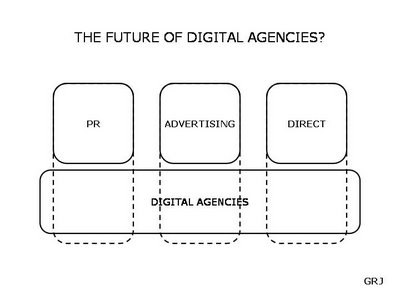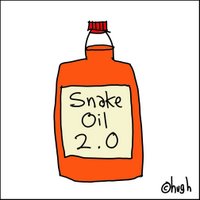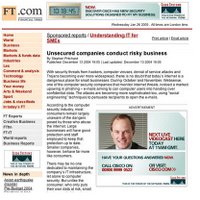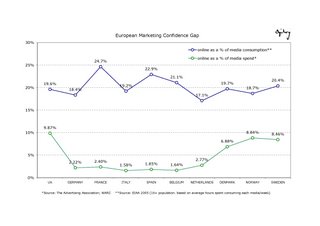
Tags: digital advertising advertising advertising trends giles rhys jones"
Technology has fundamentally changed how brands and their audiences communicate, not just online but across all channels. Consequently interactive thinking needs to be at the heart of all marketing strategy and interactive channels at the heart of all marketing delivery.
 Finally someone using SL for something other than marketing hype.
Finally someone using SL for something other than marketing hype. Another story detailing the potential demise of the ad agency as we know it from the New York Times:
Another story detailing the potential demise of the ad agency as we know it from the New York Times:Well, they are indeed the future. And they're already here. So what do we know about them? Quite a lot, as it happens.
Today's 21-year-olds were born in 1985. The internet was two years old in January that year, and Nintendo launched 'Super Mario Brothers', the first blockbuster game. When they were going to primary school in 1990, Tim Berners-Lee was busy inventing the world wide web. The first SMS message was sent in 1992, when these kids were seven. Amazon and eBay launched in 1995. Hotmail was launched in 1996, when they were heading towards secondary school.
Around that time, pay-as-you-go mobile phone tariffs arrived, enabling teenagers to have phones, and the first instant messaging services appeared. Google launched in 1998, just as they were becoming teenagers. Napster and Blogger.com launched in 1999 when they were doing GCSEs. Wikipedia and the iPod appeared in 2001. Early social networking services appeared in 2002 when they were doing A-levels. Skype launched in 2003, as they were heading for university, and YouTube launched in 2005, as they were heading toward graduation.
These kids have been socially conditioned in a universe that runs parallel to the one inhabited by most folks in the media business. They've been playing computer games of mind-blowing complexity forever. They're resourceful, knowledgeable and natural users of computer and communications technology. They're Digital Natives - accustomed to creating content of their own - and publishing it.
They buy music from the iTunes store - but continue to download tracks illicitly as well. They use BitTorrent to get US editions of Lost. They think 'Google' is a synonym for 'research' and regard it as quite normal to maintain and read blogs (55 million as of last night), use Skype to talk to their mates and upload photos to Flickr. Some even write entries on Wikipedia. And they know how to use iMovie or Adobe Premiere to edit videos and upload them to YouTube.
Now look round the average British newsroom. How many hacks have a Flickr account or a MySpace profile? How many sub-editors have ever uploaded a video to YouTube? How many editors have used BitTorrent? (How many know what BitTorrent is?)
And while some of our teenagers' interests coincide with ours, many do not. Here, for example, are the top blog tags on Technorati last night: Bush, careers, college, comedy, Congress, death, Democrats, elections, Flickr, gay, Halloween, Iraq, Microsoft, money, Republicans, Saddam, Ted Haggard, vote, war, breaking-news, tagshare, YouTube. Some you'll recognise. But you won't see much about many of these in the papers.
These are the future, my friends. They're here and living among us. They're not very interested in us, and I'm not sure I blame them. The best we can hope for is that one day they may keep us as pets.




 Adweek reports that American Express has tapped two small business owners (who also blog) as part of a campaign which recently kicked off (full disclosure, American Express is a Ogilvy client—though I have no idea if we are involved in this effort).
Adweek reports that American Express has tapped two small business owners (who also blog) as part of a campaign which recently kicked off (full disclosure, American Express is a Ogilvy client—though I have no idea if we are involved in this effort). At the OgilvyOne NY Verge Conference they launched OgilvyTransient: a go anywhere do anything team of brand editors, film makers, storytellers, planners and creative. Putting the story telling and content back into marketing comunications.
At the OgilvyOne NY Verge Conference they launched OgilvyTransient: a go anywhere do anything team of brand editors, film makers, storytellers, planners and creative. Putting the story telling and content back into marketing comunications.
 Over the past 10 years corporations have tried and failed to hijack the internet, treating it like any other medium by broadcasting their message with no respect for or dialogue with their audience. The web is now starting to return to the tenets on which it was built: collaboration, creation and power to individuals.
Over the past 10 years corporations have tried and failed to hijack the internet, treating it like any other medium by broadcasting their message with no respect for or dialogue with their audience. The web is now starting to return to the tenets on which it was built: collaboration, creation and power to individuals. The majority of really succesful campaigns are based on this priciple: Ogilvy's Cisco Livecast where a live webcast took place within an ad unit specifically negotiated with the FT.com reached millions and 60% of those who viewed the unit asked a question to the presenter live and the campign repositioned Cisco from a faceless corporate to a company who listens to it' SMB audience.
The majority of really succesful campaigns are based on this priciple: Ogilvy's Cisco Livecast where a live webcast took place within an ad unit specifically negotiated with the FT.com reached millions and 60% of those who viewed the unit asked a question to the presenter live and the campign repositioned Cisco from a faceless corporate to a company who listens to it' SMB audience. A figue appeared in the middle of the page with the title "I shouldn't be here" he then climbed back into the banner, where he should be, and explained that he had been diagnosed with testicular cancer but had survived thanks to CRUK. Intrusive, yes but with a reason and perfectly linked with the proposition.The campaign generated never before seen levels of donations.
A figue appeared in the middle of the page with the title "I shouldn't be here" he then climbed back into the banner, where he should be, and explained that he had been diagnosed with testicular cancer but had survived thanks to CRUK. Intrusive, yes but with a reason and perfectly linked with the proposition.The campaign generated never before seen levels of donations.
 Interesting to see that despite the increased media money flowing to digital channels there is a huge disconnect between the % of time people spend online and the % of money advertisers spend online. Obviously there are a couple of flaws to the data - money spend creating websites is not counted nor is simultaneous channel usage.
Interesting to see that despite the increased media money flowing to digital channels there is a huge disconnect between the % of time people spend online and the % of money advertisers spend online. Obviously there are a couple of flaws to the data - money spend creating websites is not counted nor is simultaneous channel usage. I am surprised that Dan suggests that David Ogilvy would have difficultly recognising the changing practise of advertising today. Ogilvy's belief was that deep consumer insight, coupled with big creative ideas, is the engine of brand building. Ogilvy has always been about 360 branding, using all channels to reach a consumer, always about inviting customers in, rather than forcing a broadcast message.
I am surprised that Dan suggests that David Ogilvy would have difficultly recognising the changing practise of advertising today. Ogilvy's belief was that deep consumer insight, coupled with big creative ideas, is the engine of brand building. Ogilvy has always been about 360 branding, using all channels to reach a consumer, always about inviting customers in, rather than forcing a broadcast message.